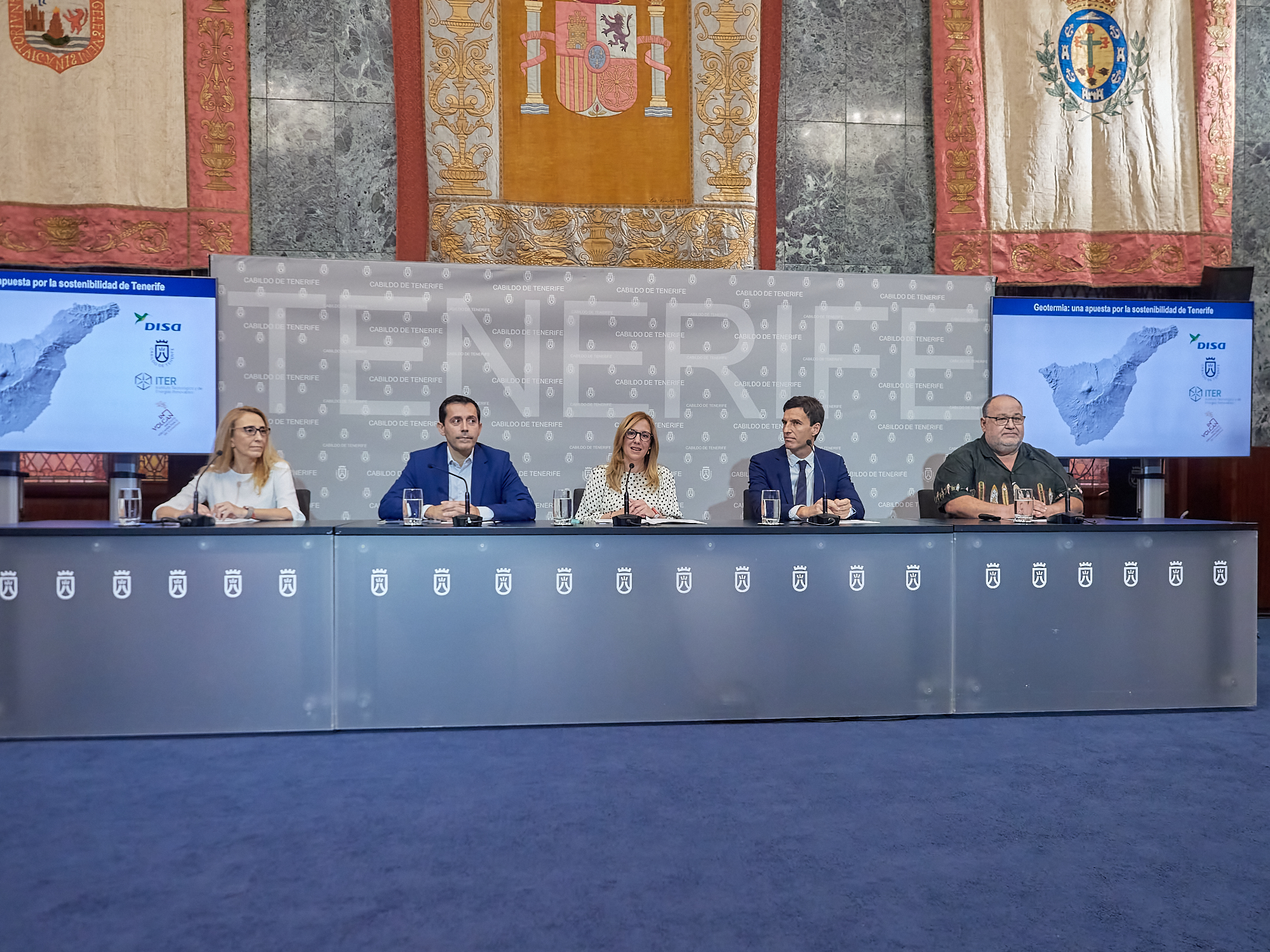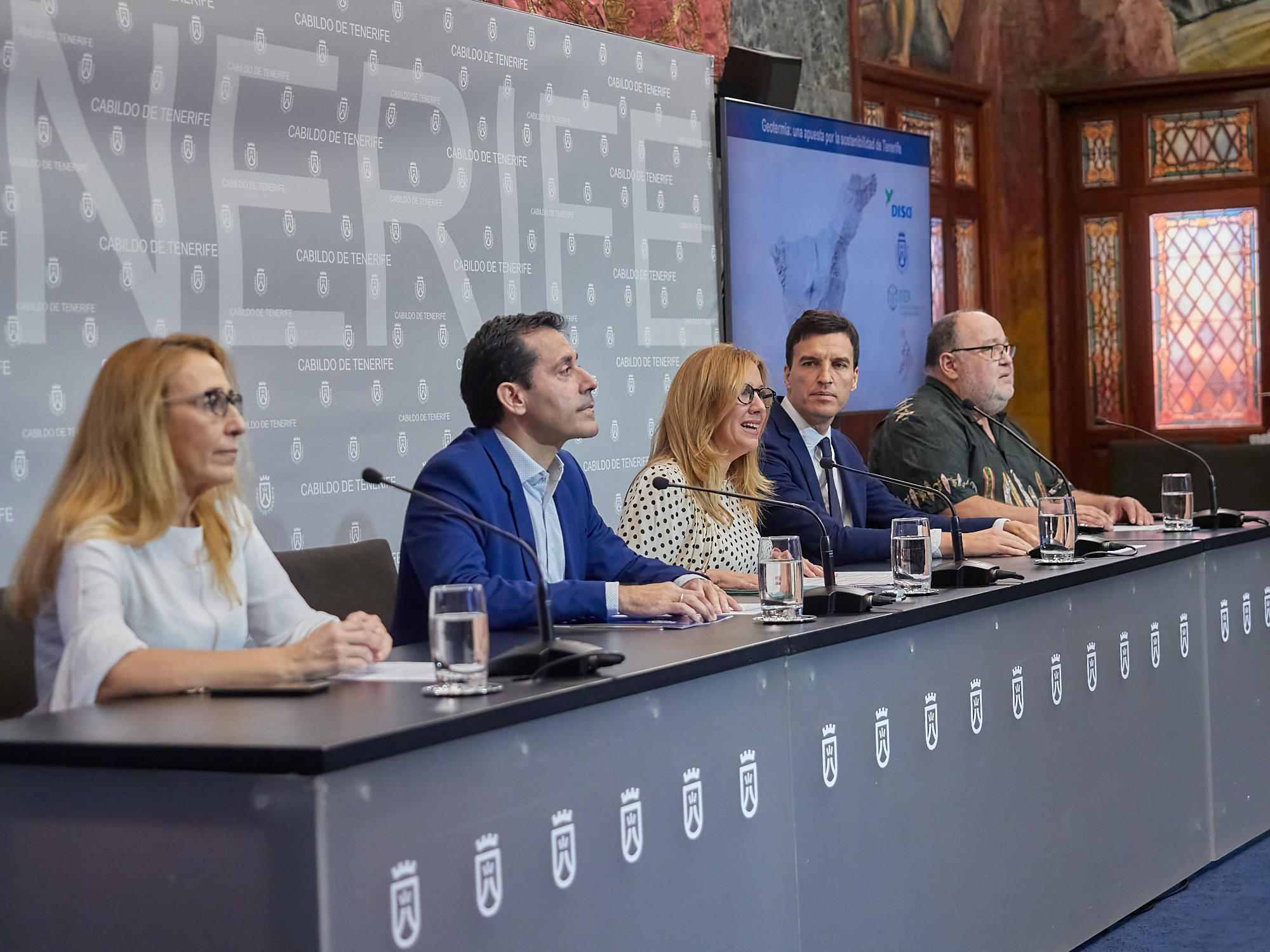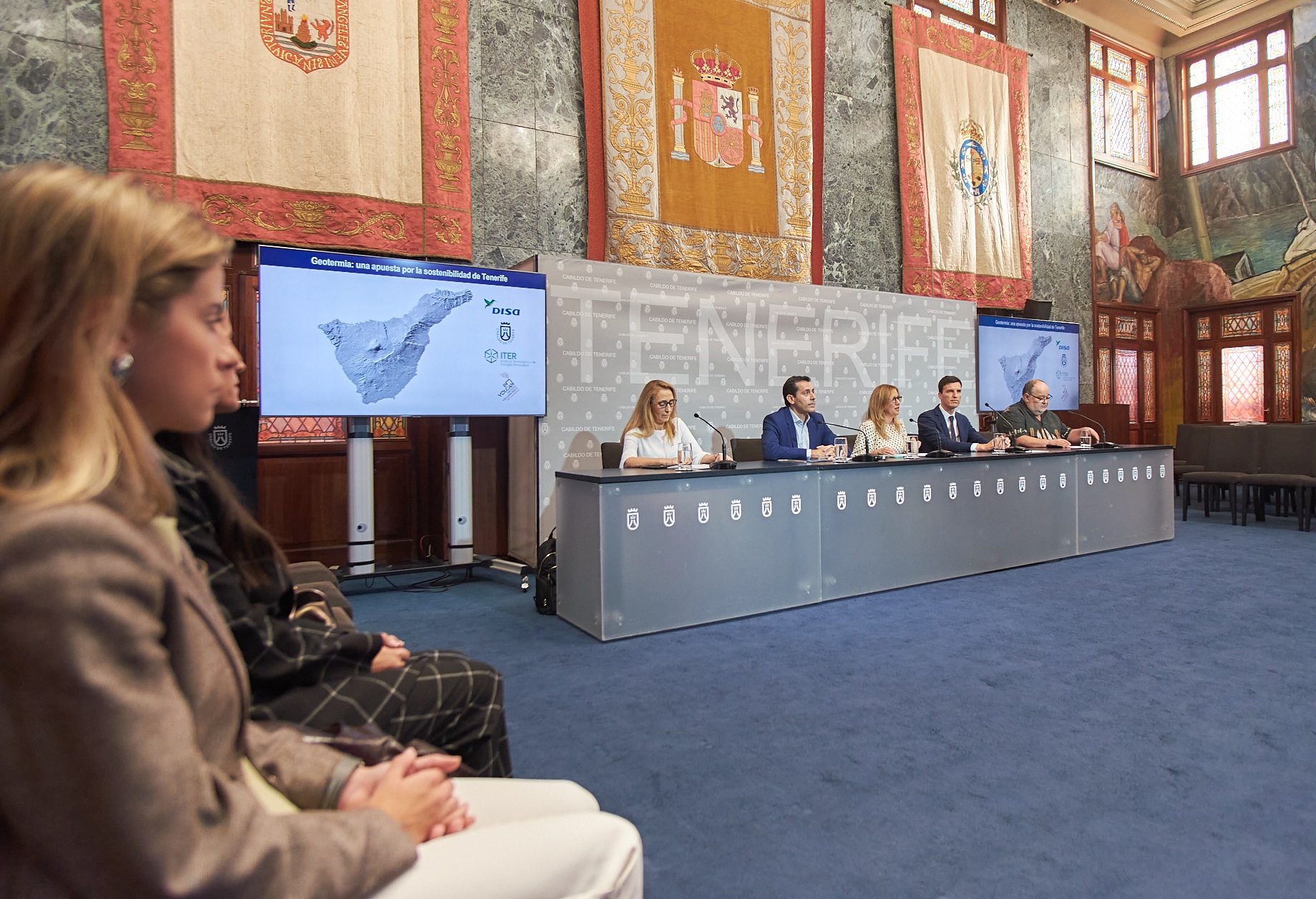The president, Rosa Dávila, highlights the public-private initiative to advance the development of renewable energies on the island.
ITER and DISA will begin surface explorations this year.
The Tenerife Island Council has hosted today (Tuesday 30) the presentation of the public-private initiative formed by the Institute of Technology and Renewable Energies, an entity dependent on the island’s corporation, and the DISA group, which has managed to secure €43.1 million in grants from the Institute for the Diversification and Saving of Energy (IDAE) for the development of geothermal energy on the island through the mining domains granted by the Government of the Canary Islands to both entities and which are linked to the volcanic-hydrothermal systems of Tenerife NWRZ, Tenerife NERZ, and Tenerife NSRZ.
The event was attended by the president of the Island Council, Rosa Dávila, the councilor for Innovation, Research and Development, Juan José Martínez; the director of DISA Renovables, Joaquín Gurriarán, and the director of the Environmental Area of the Institute of Technology and Renewable Energies (ITER) and scientific coordinator of INVOLCAN, Nemesio Pérez. The geothermal research linked to the Tenerife NERZ volcanic-hydrothermal system will be carried out partially in the municipalities of Arico, Fasnia, and La Orotava. In the case of Tenerife NWRZ, it will be partially executed in the municipalities of Buenavista del Norte, Garachico, Guía de Isora, Icod de los Vinos, Santiago del Teide, Los Silos, and El Tanque, while the geothermal research work in the Tenerife NSRZ volcanic-hydrothermal system will focus on the municipalities of Adeje, Arona, Granadilla, San Miguel, and Vilaflor.
The president of the Island Council, Rosa Dávila, pointed out that this is «a commitment to the future of Tenerife in our goal of achieving 100% renewable energy. I want to highlight the commitment of the Council, through ITER and also the work done by Involcan, and by DISA in this public-private initiative that could mean a great advance for the Island. This would allow us to increase our energy sovereignty while reducing the energy bill. We have an obligation to explore the resources in our territory, and that’s what we’re going to do in the coming months.»
For his part, Joaquín Gurriarán, said he felt «enthusiastic about advancing in this alliance with the Council» and indicated that «DISA has been betting on energy for 90 years and has been evolving, first with the commitment to photovoltaics and wind power, and now we do it with geothermal energy, which is a clean, affordable, and sustainable energy.» In this regard, he thanked the efforts of ITER and DISA personnel for obtaining the resources from IDAE to carry out the work and indicated that an Icelandic group will be incorporated into the project to contribute their knowledge and experience.
Juan José Martínez indicated that «this is an investment of €43.1 million, but it could be doubled to reach €86 million in project development. Throughout this year, we will carry out geothermal exploration on the surface, and from 2025, deep exploration with several boreholes is planned. We are talking about a stable and available resource since geothermal energy is available 24 hours a day, 365 days a year, and has predictable performance.» He also highlighted that it is an energy that does not consume much territory and that its environmental footprint is much lower than that of other energy sources.
Finally, Nemesio Pérez recalled that geothermal research in the Canary Islands is one step ahead compared to the rest of the geothermal research in the rest of the national territory. This has been developed mainly through R&D&I projects led by ITER and the Volcanological Institute of the Canary Islands (Involcan) over the past 13 years.
Regarding the geothermal projects of the Island Council and DISA, Pérez said that «this is like a football match that needs to be played. If you don’t play it, you don’t know if you win or lose. We are talking about a renewable and economical resource under our feet that harnesses the internal heat stored in the Earth’s crust to produce heat and electricity sustainably. Geothermal energy operates continuously to meet the minimum energy demand level and can be adapted to meet variable levels of energy demand.»
Geothermal energy is defined as «the energy stored in the form of heat below the Earth’s surface; inside the Earth’s crust.» Geothermal resources are found at various depths (from hundreds of meters to several kilometers) and can be used to generate both thermal and electrical energy depending on their temperature. Deep or high-temperature geothermal energy is associated with thermal anomalies in the Earth’s crust where the geothermal gradient, instead of being normal (30°C/km), is much higher, up to 200°C/km. These anomalies are usually mainly linked to volcanically and tectonically active areas.
Once the possible existence of a geothermal resource in the subsurface has been identified, after a detailed surface investigation and exploration, deep drilling is carried out until the geothermal reservoir is reached. Once the resource is found, it is exploited in geothermal power plants in which the extracted steam is injected into a turbine to generate electricity that is exported to the grid, providing stability to the electrical system as green baseload power. By being able to control the production of the geothermal resource at all times and being plants with a high capacity factor (above 90%), geothermal electricity becomes a great renewable ally of the electrical system, a role that is especially strategic in island territories as it can act as renewable backup for other interruptible renewables (photovoltaic, wind) and thus facilitate the evolution of the islands towards a 100% renewable energy mix.
Geothermal energy is distinguished from other renewables mainly by the uncertainty associated with identifying the geothermal resource in the initial phase of projects. However, once the resource has been found, verified that its exploitation is technically and economically viable, and a geothermal power plant is put into operation, the cost of the electricity generated is one of the most competitive among all renewables (LCOE between €0.04 – €0.07/kWh) according to the International Renewable Energy Agency (IRENA). These two differential factors highlight the importance of developing mechanisms that facilitate the mitigation of this initial existing risk, as has been done in other European countries where geothermal energy is being successfully implemented.
The geothermal potential in Spain is similar or even higher than that of neighboring countries, but currently, Spain has a zero level of geoelectric development, while Germany, France, and Portugal have an installed geothermal capacity for electricity generation of 40, 16, and 29 MW respectively in 2021, largely installed in the island territories of these countries. In the vision document of the Spanish Technological and Innovation Platform in Geothermal Energy (Geoplat) published in 2010, an electric generation potential for the Canary Islands in the 2020 horizon of 255 MW of installed power was estimated. The impact of this development would induce energy benefits by contributing to decarbonizing the mix and reducing high extra-peninsular energy costs. In addition to inducing significant environmental benefits by replacing fossil power plants and, most importantly, inducing socio-economic benefits in the territories by making investments that would involve job generation and maintenance.
Press conference on geothermal projects to be developed on the island of Tenerife (January 30, 2024)
Recording of the press conference, held on January 30, 2024, at the Tenerife Island Council, on the geothermal projects to be developed on the island of Tenerife, with the presence of the president of the Island Council, Rosa Elena Dávila Mamely; the councilor for Innovation, Research and Development, Juan José Martínez Díaz; the director of DISA Renovables, Joaquín Gurriarán; the director of the Environmental Area of ITER – Institute of Technology and Renewable Energies, S.A., Nemesio Pérez; and Begoña Ortiz, the CEO of ITER..



